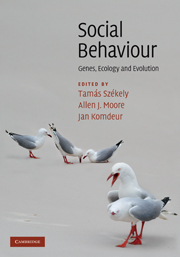Book contents
- Frontmatter
- Contents
- List of contributors
- Introduction: The uphill climb of sociobiology: towards a new synthesis
- Profile: Undiminished passion
- Part I Foundations
- 1 Nature–nurture interactions
- Profile: Social evolution, sexual intrigue and serendipity
- 2 The quantitative genetics of social behaviour
- Profile: Mating systems: integrating sexual conflict and ecology
- 3 Social behaviour and bird song from a neural and endocrine perspective
- Profile: In love with Ropalidia marginata: 34 years, and still going strong
- 4 Evolutionary game theory
- Profile: The huddler's dilemma: a cold shoulder or a warm inner glow
- 5 Recent advances in comparative methods
- Profile: Multi-component signals in ant communication
- 6 Social evolution theory: a review of methods and approaches
- Profile: What's wrong with this picture?
- Part II Themes
- Part III Implications
- Species index
- Subject index
- References
Profile: What's wrong with this picture?
Published online by Cambridge University Press: 05 June 2012
- Frontmatter
- Contents
- List of contributors
- Introduction: The uphill climb of sociobiology: towards a new synthesis
- Profile: Undiminished passion
- Part I Foundations
- 1 Nature–nurture interactions
- Profile: Social evolution, sexual intrigue and serendipity
- 2 The quantitative genetics of social behaviour
- Profile: Mating systems: integrating sexual conflict and ecology
- 3 Social behaviour and bird song from a neural and endocrine perspective
- Profile: In love with Ropalidia marginata: 34 years, and still going strong
- 4 Evolutionary game theory
- Profile: The huddler's dilemma: a cold shoulder or a warm inner glow
- 5 Recent advances in comparative methods
- Profile: Multi-component signals in ant communication
- 6 Social evolution theory: a review of methods and approaches
- Profile: What's wrong with this picture?
- Part II Themes
- Part III Implications
- Species index
- Subject index
- References
Summary
Research on wild primates was still a relatively new endeavour in the USA when I entered graduate school in 1970. Courses on primate behaviour were primarily taught in anthropology departments. I was drawn to the field because Japanese researchers had reported that adult male monkeys sometimes killed infants in a species of South Asian monkey known as the Hanuman langur Semnopithecus entellus, and I wanted to find out why. The summer after my first year in graduate school I went to Mount Abu, in Rajasthan, with this question in mind. At the time I had no special interest in female behaviour, which frankly struck me as boring.
According to the only available article on the subject, entitled ‘The female primate’, ‘Her primary focus, a role which occupies more than 70 percent of her life, is motherhood … A female raises one infant after another for her entire adult life … Dominance interaction is usually minimal’ (Jay 1963). This narrow view of female natures was the result of a combination of factors, including Victorian social biases left over from Darwin's day, the fact that earlier observations had focused on captive animals, often consisting of mothers caged individually with their young, and evolutionary theory itself. As then formulated, Darwin's remarkably original and quite powerful theory of sexual selection left out many sources of variation affecting the differential reproductive success of females.
- Type
- Chapter
- Information
- Social BehaviourGenes, Ecology and Evolution, pp. 159 - 162Publisher: Cambridge University PressPrint publication year: 2010



